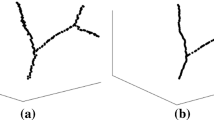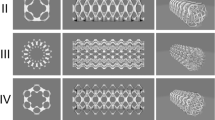Abstract
The bronchial tree reconstruction is a challenging task due to its non-uniform topological boundaries and asymmetric branching pattern. Contrary to the conventional approaches of patch stitching and triangulation, this work uses a single-patch T-spline for the reverse engineering of human airways. The proposed methodology not only captures geometric details, but also illustrates the variation in the airway’s tissue properties along with the geometry. The process has been applied to develop a 3D airway model from the computed tomography (CT) scan data with preserved material information. The multi-material domain aids in representing airways internal details accurately. The proposed method has potential applications in fabrication, FEM analysis, and tissue engineering for complex branching structures.













Similar content being viewed by others
References
Ahookhosh K, Pourmehran O, Aminfar H, Mohammadpourfard M, Sarafraz MM, Hamishehkar H (2020) Development of human respiratory airway models: a review. Eur J Pharm Sci 145:105233
Ding S, Ye Y, Tu J, Subic A (2010) Region-based geometric modelling of human airways and arterial vessels. Comput Med Imaging Graph 34:114–121
Rosell J, Cabras P (2013) A three-stage method for the 3D reconstruction of the tracheobronchial tree from CT scans. Comput Med Imaging Graph 37:430–437
Oropallo W, Piegl LA (2016) Ten challenges in 3D printing. Eng Comput 32:135–148
Li B, Fu J, Feng J, Shang C, Lin Z (2020) Review of heterogeneous material objects modeling in additive manufacturing. Vis Comput Ind Biomed Art 3:6
Li Q, Hong Q, Qi Q, Ma X, Han X, Tian J (2018) Towards additive manufacturing oriented geometric modeling using implicit functions. Vis Comput Ind Biomed Art 1:9
Warkhedkar RM, Bhatt AD (2009) Material-solid modeling of human body: a heterogeneous B-spline based approach. Comput Aided Des 41:586–597
Al Akhras H, Elguedj T, Gravouil A, Rochette M (2017) Towards an automatic isogeometric analysis suitable trivariate models generation—application to geometric parametric analysis. Comput Methods Appl Mech Eng 316:623–645
Feng C, Taguchi Y (2017) FasTFit: a fast T-spline fitting algorithm. Comput Aided Des 92:11–21
Liu L, Zhang YJ, Wei X (2015) Weighted T-splines with application in reparameterizing trimmed NURBS surfaces. Comput Methods Appl Mech Eng 295:108–126
Wang W, Zhang Y, Xu G, Hughes TJ (2012) Converting an unstructured quadrilateral/hexahedral mesh to a rational T-spline. Comput Mech 50(1):65–84
Wang W, Zhang Y, Liu L, Hughes TJ (2013) Trivariate solid T-spline construction from boundary triangulations with arbitrary genus topology. Comput Aided Des 45(2):351–360
Zhang YJ (2016) Geometric modeling and mesh generation from scanned images. Chapman and Hall/CRC, Boca Raton
Zhang Y, Wang W, Hughes TJ (2013) Conformal solid T-spline construction from boundary T-spline representations. Comput Mech 51(6):1051–1059
Li B, Fu J, Zhang YJ, Lin W, Feng J, Shang C (2020) Slicing heterogeneous solid using octree-based subdivision and trivariate T-splines for additive manufacturing. Rapid Prototyping J 26:164–175
Liu L, Zhang Y, Hughes TJ, Scott MA, Sederberg TW (2014) Volumetric T-spline construction using Boolean operations. Eng Comput 30:425–439
Pan M, Chen F, Tong W (2019) Volumetric spline parameterization for isogeometric analysis. Comput Methods Appl Mech Eng 359:112769
Vukicevic AM, Cimen S, Jagic N, Jovicic G, Frangi AF, Filipovic N (2018) Three-dimensional reconstruction and NURBS-based structured meshing of coronary arteries from the conventional X-ray angiography projection images. Sci Rep 8:1–20
Updegrove AR, Shadden SC, Wilson NM (2019) Construction of analysis-suitable vascular models using axis-aligned polycubes. J Biomech Eng 141(6):060906
Shang C, Fu J, Lin Z, Feng J, Li B (2018) Closed T-spline surface reconstruction from medical image data. Int J Precis Eng Manuf 19:1659–1671
Sederberg TW, Zheng J (2001) T-splines and T-NURCCs. ACM Trans Graph 22(3):477–484
Bazilevs Y, Calo VM, Cottrell JA, Evans JA, Hughes TJR, Lipton S, Scott MA, Sederberg TW (2010) Isogeometric analysis using T-splines. Comput Methods Appl Mech Eng 199:229–263
Joshi K, Bhatt AD (2019) Experiments with T-mesh for constructing bifurcation and multi-furcation using periodic knot vectors. Comput Aided Des Appl 16:382–395
Brown S, Bailey DL, Willowson K, Baldock C (2008) Investigation of the relationship between linear attenuation coefficients and CT Hounsfield units using radionuclides for SPECT. Appl Radiat Isot 66:1206–1212
Issac A, Parthasarathi M, Dutta MK (2015) An adaptive threshold based image processing technique for improved glaucoma detection & classification. Comput Methods Programs Biomed 122:229–244
Kiraly AP, Reinhardt JM, Ho EA, Mclennan G, Higgins WE (2005) Virtual bronchoscopy for quantitative airway analysis. Proc SPIE Med Imaging 5746:369–383
Chen Z, Zhong M, Luo Y, Deng L, Hu Z, Song Y (2019) Determination of rheology and surface tension of airway surface liquid: a review of clinical relevance and measurement techniques. Respir Res 20:1–14
Biswal PK, Banerjee S (2010) A parallel approach for affine transform of 3D biomedical images. Int Conf Electron Inf Eng 1:329–332
Parsania PS, Virparia PV (2016) A comparative analysis of image interpolation algorithms. Int J Adv Res Comput Commun Eng 5(1):29–34
Weibel ER, Sapoval B, Filoche M (2005) Design of peripheral airways for efficient gas exchange. Respir Physiol Neurobiol 148:3–21
Asthana V, Bhatt AD (2017) G1 continuous bifurcating and multi-bifurcating surface generation with B-splines. Comput Aided Des Appl 14:95–106
Li B, Fu J, Zhang YJ, Pawar A (2020) A trivariate T-spline based framework for modeling heterogeneous solids. Comput Aided Geom Des 81:101882
Yang KH (2018) Chapter 3: isoparametric formulation and mesh quality. Basic finite element method as applied to injury biomechanics. Academic Press, Cambridge, pp 111–149
Ikuchi KEK, Aga TOH, Suruta KENU, Eno HIU, Shikawa TAI (2017) Effect of fluid viscosity on the cilia-generated flow on a mouse tracheal lumen. Ann Biomed Eng 45:1048–1057
Lawrence DA, Branson B, Oliva I, Rubinowitz A (2014) MDCT of the central airways: anatomy and pathology. Appl Radiol 43:8–21
Eom JS, Kim H, Jeon K, Um SW, Koh WJ, Suh GY, Chung MP, Kwon OJ (2013) Tracheal wall thickening is associated with the granulation tissue formation around silicone stents in patients with post-tuberculosis tracheal stenosis. Yonsei Med J 54(4):949–956
Dettmer S, Entrup J, Schmidt M, Wall CD, Wacker F, Shin H (2012) Bronchial wall thickness measurement in computed tomography: Effect of intravenous contrast agent and reconstruction kernel. Eur J Radiol 81(11):3606–3613
Telenga ED et al (2017) Airway wall thickness on HRCT scans decreases with age and increases with smoking. BMC Pulm Med 17(1):27
Patyk M, Obojski A, Sokołowska-Dąbek D, Parkitna-Patyk M, Zaleska-Dorobisz U (2020) Airway wall thickness and airflow limitations in asthma assessed in quantitative computed tomography. Ther Adv Respir Dis 14:1–10
Ulusoy M, Uysal II, Kivrak AS, Ozbek S, Karabulut AK, Paksoy Y, Dogan NU (2016) Age and gender related changes in bronchial tree: a morphometric study with multidedector CT. Eur Rev Med Pharmacol Sci 20(16):3351–3357
Seymour AH (2003) The relationship between the diameters of the adult cricoid ring and main tracheobronchial tree: a cadaver study to investigate the basis for double-lumen tube selection. J Cardiothorac Vasc Anesth 17(3):299–301
Author information
Authors and Affiliations
Corresponding author
Additional information
Publisher's Note
Springer Nature remains neutral with regard to jurisdictional claims in published maps and institutional affiliations.
Rights and permissions
About this article
Cite this article
Joshi, K., Bhatt, A.D. Building a T-spline-based tri-variate heterogeneous model of human airways: a reverse engineering approach. Engineering with Computers 38, 4085–4097 (2022). https://doi.org/10.1007/s00366-021-01569-3
Received:
Accepted:
Published:
Issue Date:
DOI: https://doi.org/10.1007/s00366-021-01569-3




